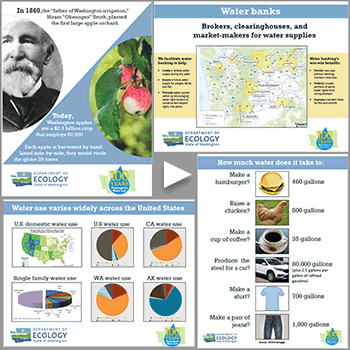The history of water law
In 1917, the state passed its first water law, establishing that those who first put water to a good use retain the right to continue using it in the future. In the hundred years since, new laws and court rulings have influenced how we manage water resources for Washington communities, farms, fish, and businesses.
We’re commemorating the first hundred years of Washington water law with videos and a multi-media presentation that will expand your understanding of how these laws — and the precious water they protect — affect you and the places where you live and work.
A resource held in common
Water is a resource held in common by state residents. The right to use the water is subject to regulation to ensure that water is used beneficially and to protect the environment. Without controls, conflicts would flare, as they did in the years before the Legislature enacted the 1917 water code.
Learn how water and water laws have shaped state history and play an important role in supporting Washington's communities, industries, farms, and environment.
100 Years of Water Law
An informative, entertaining multi-media tour through the state’s varied history of water use, including: communities, farms, industry, tribal rights, the Columbia River, dam safety, and the future.You can navigate this "story map" by scrolling up and down. You can also view it full screen on your computer.
The history of Washington state water rights
A look at the origins of early water laws and the protections they provide to our water supplies today.A rural landowner's guide to Washington's water law
An overview of the permit-exempt use of groundwater, including new rules for new wells.Where your water comes from
From the hydrologic cycle to rivers, wells, and reservoirs — how municipalities serve your water needs.100 years of water law – infographic set
Twelve posters that are sure to start a conversation about how water is used, managed, and threatened by increasing demand and a changing climate.Water today – water tomorrow
Over the past hundred years, water laws have changed. As communities grew, demand increased and court decisions shifted the balance between competing interests. Recent influences include:
-
Scientific research establishing the continuity of ground and surface waters and the potential effects of well pumping on streamflows.
-
Instream flow rules granting water rights to surface waters to protect instream resources including fish, navigation, and aesthetics.
-
Growth management requirements that compel local governments to consider water availability when planning.
-
Climate changes and warmer temperatures that are affecting precipitation, streamflows, and snowpack.
Today’s challenges are very different from those in 1917, when water seemed like an unlimited resource. Now, we’re ensuring water resources are managed to meet agricultural needs and a growing population, while at the same time protecting existing water rights, important fisheries, and other environmental resources.


